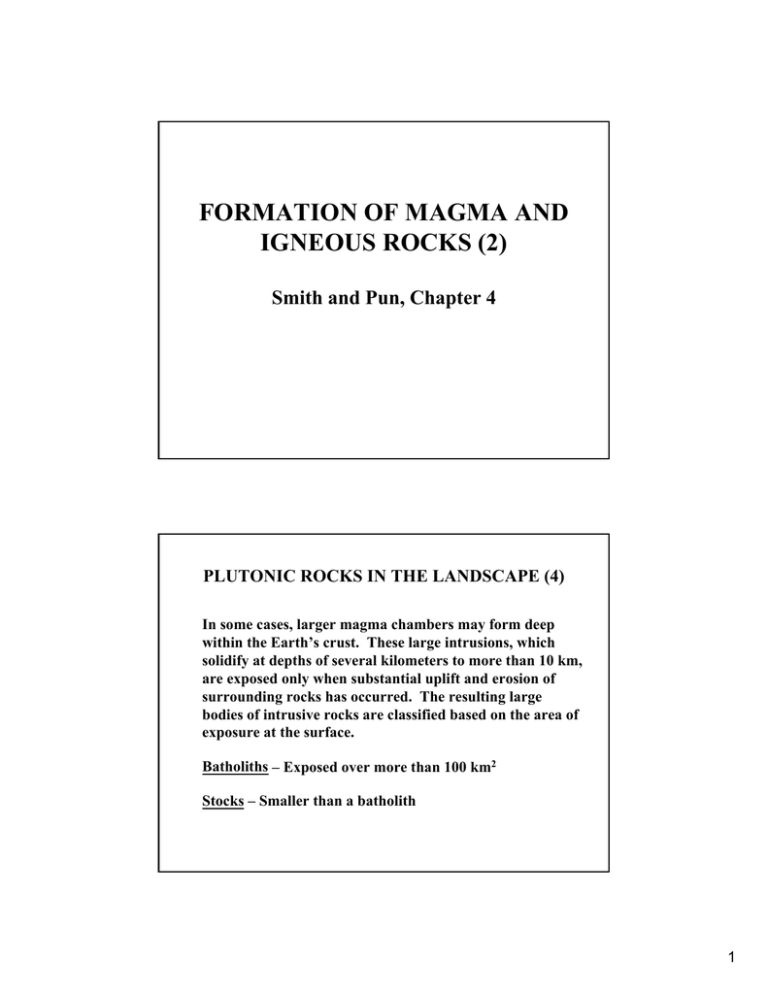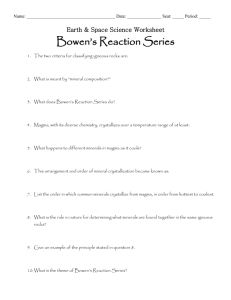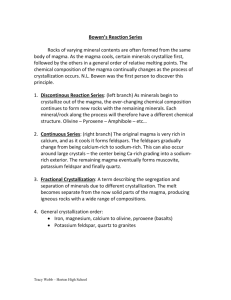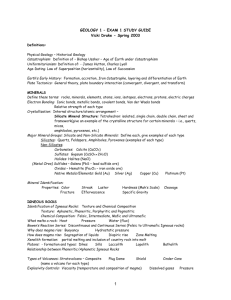FORMATION OF MAGMA AND IGNEOUS ROCKS (2) Smith and Pun, Chapter 4
advertisement

FORMATION OF MAGMA AND IGNEOUS ROCKS (2) Smith and Pun, Chapter 4 PLUTONIC ROCKS IN THE LANDSCAPE (4) In some cases, larger magma chambers may form deep within the Earth’s crust. These large intrusions, which solidify at depths of several kilometers to more than 10 km, are exposed only when substantial uplift and erosion of surrounding rocks has occurred. The resulting large bodies of intrusive rocks are classified based on the area of exposure at the surface. Batholiths – Exposed over more than 100 km2 Stocks – Smaller than a batholith 1 VOLCANIC ROCKS IN THE LANDSCAPE Volcanic rocks, like plutonic rocks, may take on a variety of landscape forms at both small and large scales. Lava flows are the most common features (see Figures 4.94.11, pages 76-77). Basaltic lava flows may be only a few meters thick (Hawaii) or cover very large areas (Pacific Northwest). Intermediate and felsic lava flows are tens to hundreds of meters thick, but extend only a few kilometers from the vent from which they erupted. VOLCANIC ROCKS IN THE LANDSCAPE (4) Pyroclastic flow deposits (see Figure 4.13, page 78) form when avalanches of pumice and ash flow down the slopes of a volcano. Ash and lapilli fragments remain sticky and plastic if these deposits retain heat after coming to rest. The particles in the interior of the deposit may become squashed and stick together under the weight of the overlying material, producing welded tuff. 2 TYPES OF VOLCANOES Volcanoes are hills, ridges, or mountains that formed by the accumulation of lava flows and pyroclastic deposits around the vent, or conduit, from which they erupted. Volcanoes are classified based on their size, shape, and the erupted volcanic materials (Figure 4.14, page 79). 3 GENERAL VOLCANIC FORMS 3 FORMATION OF CALDERAS A caldera is a circular or elliptical depression of the Earth’s surface that forms when a significant volume of magma is removed from a shallow magma chamber, and is not immediately replenished, resulting in the collapse of the roof of the magma chamber. WHY ROCKS MELT Measurements in drilled wells and mine shafts confirm that temperature increases with increasing depth beneath the Earth’s surface. The relationship of increasing temperature as a function of depth is called the geothermal gradient. • Below continents the temperature increases approximately 25 to 30°C with each kilometer beneath the surface. • The average geothermal gradient beneath the oceans is 60°C per kilometer. 4 WHY ROCKS MELT (2) Comparison of the geothermal gradients to the melting temperature of peridotite in the mantle reveals the following: • Although temperature increases with depth, the melting temperature also increases because of increasing pressure (see Figure 4.18a, page 84). Average continental geothermal gradients are not hot enough to cause melting in the mantle, and only minor amounts of partial melting at the depth of about 100 km is likely beneath the oceans. WHY ROCKS MELT (3) Based on the information depicted in Figure 4.18a, it appears that it is difficult to make magma. This is why volcanoes are not abundant at the Earth’s surface. Other ways that mantle peridotite could be melted include: • Decrease the pressure (see Figure 4.18b, page 84). Rock does not cool down rapidly as it rises toward the surface. Very hot, but still solid, peridotite deep in the mantle melts at shallow depth and lower pressure. 5 WHY ROCKS MELT (4) • Addition of water also lowers the melting point of peridotite (see Figure 4.18c, page 84). BOWEN’S REACTION SERIES The process of crystallization actually resembles melting in reverse. As the temperature of magma decreases, individual minerals begin to crystallize. The minerals generally appear in the opposite order of which they melted. As crystallization proceeds, the mineral composition of the magma changes and early-formed crystals may dissolve as new minerals crystallize. 6 BOWEN’S REACTION SERIES THE CONNECTION BETWEEN MAGMA GENERATION AND PLATE TECTONICS Melting at Divergent Plate Boundaries and Hot Spots 1. Hot mantle rock can retain much of its heat as it rises close to Earth’s surface. However, at divergent plate boundaries the hot asthenosphere rises and fills the spaces where the oceanic lithosphere separates. This results in lower pressure as the mantle peridotite rises. 2. Decompression melting also occurs where unusually hot mantle rock rises at hot spots such as Hawaii and Iceland (see Figure 4.21a, page 87). 3. Where divergent plate boundaries or hot spots are located within continents, decompression melting of the mantle to form basalt also occurs. 7 WHY IGNEOUS ROCK COMPOSITIONS ARE SO DIVERSE Igneous rock compositions are diverse because of the diversity of the magmas from which they were formed. Four processes account for this diversity: 1. 2. 3. 4. Melting of equally diverse source rocks to different extents Deriving one magma composition from another (Figure 4.22 and 4.23, pages 89-90) Assimilating surrounding rock into the rising magma, and Blending magmas of different composition to produce a new composition WHY IGNEOUS ROCK COMPOSITIONS ARE SO DIVERSE (2) Melting of Diverse Source Rocks Different original materials produce different magmas. • Melting mantle peridotite generates basaltic magma. • Melting subducted basalt produces dacitic magma. • Melting continental crust results in an even more felsic magma. Therefore, different source rock composition as well as varying degrees of melting of the same source rock result in different magma compositions. 8 WHY IGNEOUS ROCK COMPOSITIONS ARE SO DIVERSE (3) Deriving One Magma Composition from Another The composition of the magma changes as crystallization begins to occur (see Figure 4.22, page 89). The first mineral to crystallize while the magma is cooling has a different composition than the whole magma. Elements that are preferentially incorporated within the crystallized minerals become depleted, or less abundant in the remaining magma. WHY IGNEOUS ROCK COMPOSITIONS ARE SO DIVERSE (4) Deriving One Magma Composition from Another Early crystallized minerals separate from magma from which they were derived, and result in changes in the composition of the remaining melt (see Figure 4.23, page 90). If the crystallized minerals are more dense than the liquid, they may settle to the bottom of the magma chamber. These accumulations often form significant natural economic deposits. Examples include Stillwater, Montana where metal ores of oxide minerals are mined, and the Bushveld Complex in South Africa, the world’s principal supplier of chromium form the oxide mineral chromite. 9 WHY IGNEOUS ROCK COMPOSITIONS ARE SO DIVERSE (5) Deriving One Magma Composition from Another Some igneous intrusions exhibit an inward zonation of progressively more felsic compositions (right hand side of Figure 4.23, page 89). In this case, high-temperature minerals crystallize first along the cooler walls of the intrusion. As the intrusion continues to solidify inward, the remaining magma is progressively enriched in silica and other elements that are less abundant in the minerals forming first. This process is called fractional crystallization, because each fraction of the magma that crystallizes results in a melt of new composition. WHY IGNEOUS ROCK COMPOSITIONS ARE SO DIVERSE (6) Magma Assimilation As magma rises toward the surface, it comes in contact with, and may incorporate, pieces of the surrounding rock. These rocks may partially or completely melt and mix into the magma, which changes its composition. This process is called assimilation. Assimilation does not occur on a large scale, because of the large amount of heat required to melt the surrounding rock. Loss of this amount of heat would lower the temperature of the magma and result in solidification before extensive solidification could occur. 10 WHY IGNEOUS ROCK COMPOSITIONS ARE SO DIVERSE (7) Magma Mixing Magma mixing is another process resulting in the formation of a compositionally distinct magma. For example, many large batholiths form from numerous injections of magma. As new magma arrives, it comes into contact with the existing magma which may have a different composition. DIFFERENCES IN EXPLOSIVITY OF VOLCANOES There are two properties of magma that account for the variations in the explosivity of volcanoes and the resulting landforms (see Figure 4.24, page 91). The first factor is the gas content of the magma. The higher the gas content, the more explosive the eruption (see Figure 4.25, page 92). The second factor is the viscosity, or resistance to flow, of the magma. Viscosity varies with magma composition; the higher the silica content, the higher the viscosity. 11







